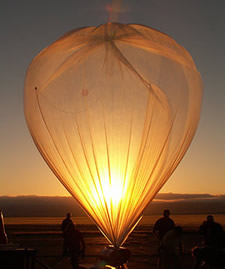 |

Test launch of the driftsonde in Wyoming, summer of
2006. Photo by JoeVanAndel, courtesy of and copyright by UCAR.
|
At our October, 2006 meeting, Joe VanAndel at NCAR discussed how Linux
ran the NCAR/CNES dropsonde project that investigated the hurricane
formation zone off the west coast of Africa.
NCAR worked with the French Space Agency to create and carry a payload
that would float west from Africa into the hurricane formation zone.
The balloon floated at 20,000 meters and higher, which is above the
tropopause, the altitude at which the troposphere (where most of our
weather takes place) gives way to the stratosphere. The gondola
consisted of a single-board Linux system and batteries well-insulated
from the cold, with an array of 24 to 40 dropsondes beneath it. Each
dropsonde was connected to the Linux system, which was able to heat
its batteries (the atmosphere is -70 degrees C up there) and drop the
sonde on command. To the casual observer, the payload and dropsonde
array looked as if it was constructed from cardboard, but Joe assured
the audience that it was really a "cellulose composite." (Amazing what
you can get away with when you're above the weather.)

Joe describing the parachute opening from the dropsonde
|

The gondola (left) and its dropsonde array (right) were
built from "cellulose composite."
|
The Linux control system was accessible through a 2400-baud connection
to the ground station in France through the Iridium network. Remember
this global network of satellites that was supposed to connect
satellite phones across the globe? In the dot-com bust its assets were
bought for less than the cost of building and launching a single
satellite, let alone worldwide ground support.
Its infrastructure has been put to uses such as this
(and a lots of military customers). Both the balloon and its
dropsondes each had GPS receivers, so that the balloon could be
tracked, and so that the dropsondes' horizontal movements could be
translated into wind speeds at the altitudes through which it dropped
by parachute. In addition to wind speed, the dropsondes transmitted
temperature, and humidity information to the gondola through a 400 MHz
radio connection.
One of the exciting parts of the project came when the project
engineers discovered that the heating protocol for the dropsondes
needed to be changed. Apparently, the on/off pattern of when heat was
applied to the dropsonde's batteries wasn't sufficient to prevent the
electronics from flaking out as the probe parachuted to the ground.
Because the system was just a Linux box, Joe could modify the control
software, use old-fashioned xmodem to upload a new control system,
kill the old process and start the new one. Joe anticipated that this
wouldn't be the last time the heating protocol would have to be
changed, so he made it programmable through his favorite scripting
language, Python. Once he uploaded the new control software, he could
tweak the heating patterns simply by uploading a new script, much
easier over a 2400-baud connection.
Joe's presentation slides are available
here (PDF 6.7MB).

|
 |



